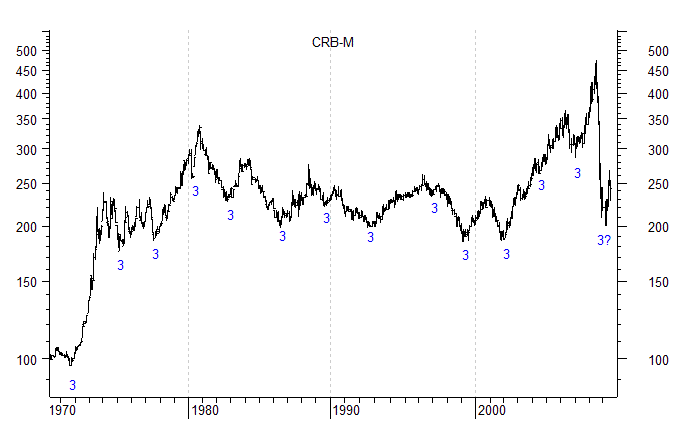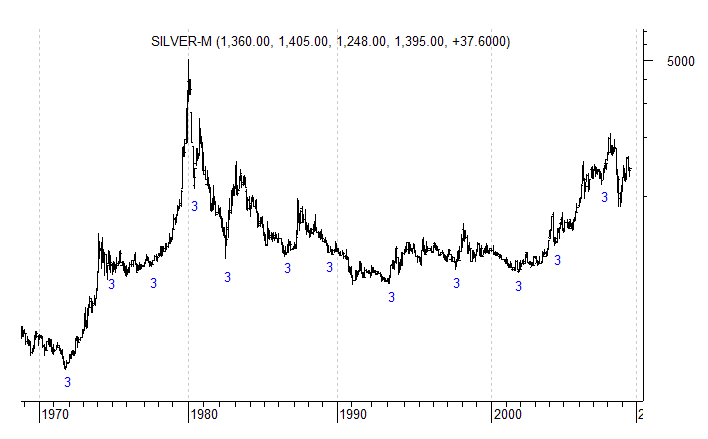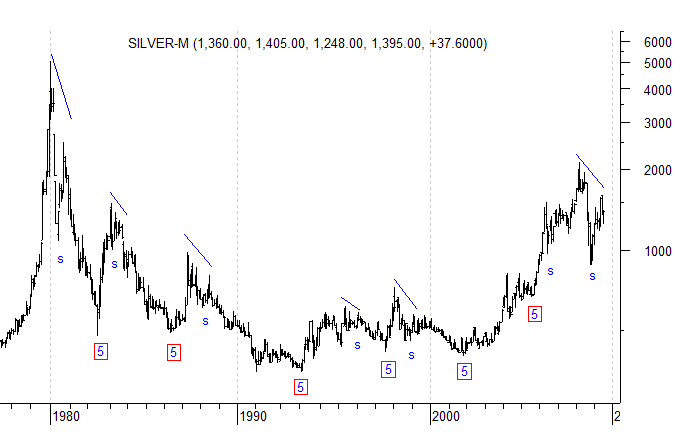Long Term Look at the Commodities CRB and Silver
Commodities / CRB Index Aug 01, 2009 - 04:28 PM GMTBy: Tim_Wood
 Every market is comprised of cycles of various durations. Each of these cycles is constantly ebbing and flowing with one another much like the currents, the tide, the waves and ripples in the ocean. Sometimes these different cycles are moving together and sometimes they move in opposition. In cycles analysis the trend is defined as the direction of the next larger cycle.
Every market is comprised of cycles of various durations. Each of these cycles is constantly ebbing and flowing with one another much like the currents, the tide, the waves and ripples in the ocean. Sometimes these different cycles are moving together and sometimes they move in opposition. In cycles analysis the trend is defined as the direction of the next larger cycle.
If the tide is going out it does not matter that the smaller degree movements are moving in opposition to the tide. The trend is set by the tide. The same is true for the markets. What we try to do is identify changes in the direction of the tide. This is not a science, but we can use the behavior of previous cycles to develop expectations for the future. These expectations are developed based on the quantitative data of previous cycles that can then be applied to the present in an effort to make educated assessments about the present.
Today, I want to start with a look at a longer-term cycle in the CRB known as the 3-year cycle. The direction of this cycle is like the tide. When it is coming in, commodity prices rise as the general direction is up in spite of the shorter-term cyclical movements, which could be moving down. When the tide turns and the 3-year cycle tops, the general direction is then down and prices will move lower from that point until low tide is reached. No amount of reasoning under the sun will change this naturally occurring phenomenon, as the cycle will have its way. The only question might be just how high or how low the tide may be.
Below is a monthly chart of the CRB. You can see that I have marked each one of the 3-year cycle lows. Like any other cycle, this cycle can contract or expand, but it has historically averaged 35.5 months in duration from low to low. This cycle is now in its 30th month with the February low having occurred on the 25th month. Historically, there has never been a cycle to contract to 25 months. So, from that perspective it is questionable as to whether the 3-year cycle low has been seen. The details of this have been covered in previous newsletters. Anyway, based on these historical averages alone, the tide is still moving out and once this upward wave has peaked it will then pull commodity prices down with it. The confirmation of the downturn of this wave will come with a downturn of my intermediate-term Cycle Turn Indicator and ultimately with the monthly Cycle Turn Indicator.

Now I want to look at the impact that the 3-year cycle in the CRB has on the silver market. Below is a monthly chart of silver. I have marked the corresponding 3-year cycle lows in the CRB on the silver chart. There is no denying that the 3-year cycle in the CRB has a definite impact on silver prices. As you can see from this historical data, this impact is simply a matter of record and not opinion based.

Now the danger to silver, as I see it, is that there is evidence suggesting the 3-year cycle low in the CRB still lies ahead. If so and if the historical relationship between this cycle in the CRB and silver, as shown here for the last 30 years, holds true, then silver is at risk of being pulled down by the downward tidal forces as the CRB moves into its 3-year cycle low. The only questions are, could the CRB have bottomed in February, which is statistically unlikely, and if not how much will this force pull the silver market down?
Let’s get away from the CRB now and take a closer look at silver itself. In doing so, I want to shift our focus to the shorter-term annual cycle in silver. This cycle averages just less than one year and for this reason we call it an annual or seasonal cycle. I have marked this cycle’s low with an “s” on the monthly chart below.
I use quantitative data gathered from the behavior of previous cycles to develop expectations for future cycles. When looking at the data surrounding the seasonal cycle in silver, history shows that 76.19% of all seasonal cycles that have failed to move above the previous seasonal cycle high have moved below the previous seasonal cycle low. An obvious example of this can be seen with the 1980 seasonal cycle top. In this case the seasonal cycle bottomed in May 1980 and began moving up toward the all time highs again. But, this cycle topped before these levels could be bettered. The result was a decline that carried silver well below the May 1980 low. When a cycle fails to move above a previous cycle high, I refer to this behavior as a cyclical failure. Other examples of these cyclical failures at the seasonal cycle tops occurred in 1981, 1983 1984, 1985, 1987, 1988, 1989, 1994, 1996, 1997, 1999 and 2000. Each of these cyclical failures lead to declines that moved below the previous seasonal cycle lows. I’ve marked a few of the more obvious examples of this in blue on the chart below. 1975 and 2005 are two examples where this pattern did not hold true. In some cases these declines were modest and in some they were fairly dramatic, but again, on average, 76.19% of these failures have lead to declines below the previous seasonal cycle low.
October 2008 marked the most recent seasonal cycle low at 8.78. As you can see on the monthly chart below, the seasonal advance out of that low has failed to exceed its previous seasonal cycle high. Therefore, we now have a cyclical failure in the making and the historical quantifications are telling us that silver now has a 76.19% chance of a move below the October 2008 low. It would take a move above the March 2008 high, with the current seasonal cycle advance, to invalidate this setup. Based on the current setup, I do not currently see this happening. However, the intermediate-term Cycle Turn Indicator and the intermediate-term cyclical structure is now key and the developments over the next few weeks or so are very important.
Next, I want to look at one of the longer-term dominant cycles in silver. This cycle averages some 5-years in duration. You can see that I have marked these lows on the chart below. Silver is now in its 4th year for the current 5-year cycle. The next low point for this cycle is ideally due in 2010.

So, we know that the cycle is getting long, but what can help us to identify this cycle’s top? For this answer we can turn back to the seasonal cycle. Notice that each of the previous 5-year cycle tops have occurred with a failed seasonal cycle. I have marked each of the proceeding failed seasonal cycle lows with an “s” and the failed tops with a downward sloping trend line. Again, we currently have a failed seasonal cycle in the making. Given that this cyclical failure has occurred at all previous 5-year cycle tops, along with the fact that we are in the 4th year of the current cycle, this is all highly suggestive that the top for the current 5-year cycle has likely been made and that the low still lies ahead.
When we combine the fact that the 3-year cycle in the CRB likely has another leg down into its 3-year cycle low, it does appear that silver is now at high risk for a significant downturn. This does not necessarily mean that silver will collapse. But, it does mean that odds seem to be against silver at this time and according to this data it is supportive of a top for the 5-year cycle and lower prices now appear to be in the cards rather than higher prices. How far down it goes and whether or not this historical setup continues to develop is another story and I will be covering this in the newsletter and updates as this continues to evolve. With the dollar now at now at its lows for the year, we are at a critical juncture in regard to this setup and the next few weeks should be very very important as to which way this mop is actually going to flop.
I have begun doing free Friday market commentary that is available at www.cyclesman.info/Articles.htm so please begin joining me there. The specifics on Dow theory, my statistics, model expectations, and timing are available through a subscription to Cycles News & Views and the short-term updates. In the June issue I cover the statistical implications for commodities, gold and the current cyclical and statistical implications for the current advance in the stock market. A subscription also includes a very detailed slide show presentation on the big picture in equities, the 4-year cycle, commodities and what is expected to come. I also provide important turn point analysis using the unique Cycle Turn Indicator on the stock market, the dollar, bonds, gold, silver, oil, gasoline, the XAU and more. A subscription includes access to the monthly issues of Cycles News & Views covering the Dow theory, and very detailed statistical based analysis plus updates 3 times a week.
By Tim Wood
Cyclesman.com
© 2009 Cycles News & Views; All Rights Reserved
Tim Wood specialises in Dow Theory and Cycles Analysis - Should you be interested in analysis that provides intermediate-term turn points utilizing the Cycle Turn Indicator as well as coverage on the Dow theory, other price quantification methods and all the statistical data surrounding the 4-year cycle, then please visit www.cyclesman.com for more details. A subscription includes access to the monthly issues of Cycles News & Views covering the stock market, the dollar, bonds and gold. I also cover other areas of interest at important turn points such as gasoline, oil, silver, the XAU and recently I have even covered corn. I also provide updates 3 times a week plus additional weekend updates on the Cycle Turn Indicator on most all areas of concern. I also give specific expectations for turn points of the short, intermediate and longer-term cycles based on historical quantification.
Tim Wood Archive |
© 2005-2022 http://www.MarketOracle.co.uk - The Market Oracle is a FREE Daily Financial Markets Analysis & Forecasting online publication.



